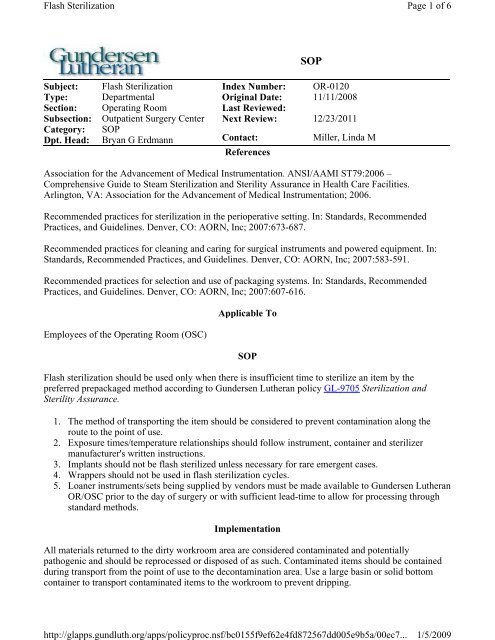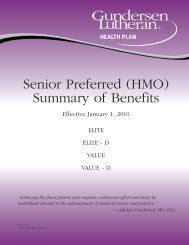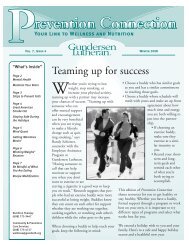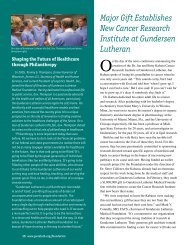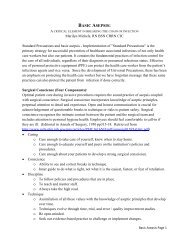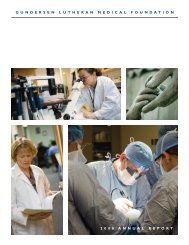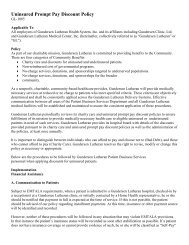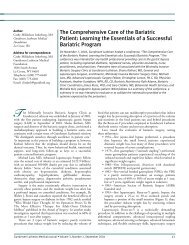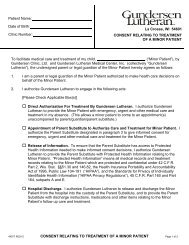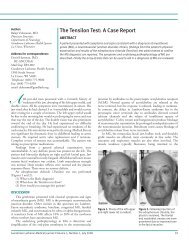Flash Sterilization Index Number: OR-0120 Type - Gundersen ...
Flash Sterilization Index Number: OR-0120 Type - Gundersen ...
Flash Sterilization Index Number: OR-0120 Type - Gundersen ...
You also want an ePaper? Increase the reach of your titles
YUMPU automatically turns print PDFs into web optimized ePapers that Google loves.
<strong>Flash</strong> <strong>Sterilization</strong><br />
http://glapps.gundluth.org/apps/policyproc.nsf/bc0155f9ef62e4fd872567dd005e9b5a/00ec7...<br />
Page 1 of 6<br />
1/5/2009<br />
SOP<br />
Subject: <strong>Flash</strong> <strong>Sterilization</strong> <strong>Index</strong> <strong>Number</strong>: <strong>OR</strong>-<strong>0120</strong><br />
<strong>Type</strong>:<br />
Section:<br />
Subsection:<br />
Departmental<br />
Operating Room<br />
Outpatient Surgery Center<br />
Original Date:<br />
Last Reviewed:<br />
Next Review:<br />
11/11/2008<br />
12/23/2011<br />
Category: SOP<br />
Dpt. Head: Bryan G Erdmann<br />
Contact:<br />
Miller, Linda M<br />
References<br />
Association for the Advancement of Medical Instrumentation. ANSI/AAMI ST79:2006 –<br />
Comprehensive Guide to Steam <strong>Sterilization</strong> and Sterility Assurance in Health Care Facilities.<br />
Arlington, VA: Association for the Advancement of Medical Instrumentation; 2006.<br />
Recommended practices for sterilization in the perioperative setting. In: Standards, Recommended<br />
Practices, and Guidelines. Denver, CO: A<strong>OR</strong>N, Inc; 2007:673-687.<br />
Recommended practices for cleaning and caring for surgical instruments and powered equipment. In:<br />
Standards, Recommended Practices, and Guidelines. Denver, CO: A<strong>OR</strong>N, Inc; 2007:583-591.<br />
Recommended practices for selection and use of packaging systems. In: Standards, Recommended<br />
Practices, and Guidelines. Denver, CO: A<strong>OR</strong>N, Inc; 2007:607-616.<br />
Employees of the Operating Room (OSC)<br />
Applicable To<br />
<strong>Flash</strong> sterilization should be used only when there is insufficient time to sterilize an item by the<br />
preferred prepackaged method according to <strong>Gundersen</strong> Lutheran policy GL-9705 <strong>Sterilization</strong> and<br />
Sterility Assurance.<br />
SOP<br />
1. The method of transporting the item should be considered to prevent contamination along the<br />
route to the point of use.<br />
2. Exposure times/temperature relationships should follow instrument, container and sterilizer<br />
manufacturer's written instructions.<br />
3. Implants should not be flash sterilized unless necessary for rare emergent cases.<br />
4. Wrappers should not be used in flash sterilization cycles.<br />
5. Loaner instruments/sets being supplied by vendors must be made available to <strong>Gundersen</strong> Lutheran<br />
<strong>OR</strong>/OSC prior to the day of surgery or with sufficient lead-time to allow for processing through<br />
standard methods.<br />
Implementation<br />
All materials returned to the dirty workroom area are considered contaminated and potentially<br />
pathogenic and should be reprocessed or disposed of as such. Contaminated items should be contained<br />
during transport from the point of use to the decontamination area. Use a large basin or solid bottom<br />
container to transport contaminated items to the workroom to prevent dripping.
<strong>Flash</strong> <strong>Sterilization</strong><br />
http://glapps.gundluth.org/apps/policyproc.nsf/bc0155f9ef62e4fd872567dd005e9b5a/00ec7...<br />
Page 2 of 6<br />
1/5/2009<br />
Cleaning and disinfecting will be performed within the confines of the dirty workroom and ante room<br />
area (room between <strong>OR</strong> 1 and <strong>OR</strong> 2). This area is physically isolated from the other divisions of the<br />
OSC department and shall maintain a minimum of 10 air exchanges with 2 outside air exchanges per<br />
hour with all return air directed to the outside.<br />
Ultrasonic washing instruments for flash sterilization<br />
Ultrasonic cleaning provides an intense scrubbing action that leads to unsurpassed cleaning speed and<br />
consistency when compared with simple soaking or immersion with agitation. Refer to CS-7680<br />
Operation of: Ultrasonic Cleaner-Crest. The ultrasonic chamber is cleaned every morning and filled<br />
with Infection Control approved enzymatic cleaning solution by the OCS Surgical Support Technician.<br />
When cleaning heavily soiled items or a large number of items, change cleaning solutions frequently to<br />
avoid recontamination of instruments.<br />
1. Wear appropriate PPE such as masks, goggles or face shields, gloves, and gowns.<br />
2. Try to separate soiled instruments from clean.<br />
3. Use basin or sink with water and Infection Control approved enzymatic cleaning solution.<br />
4. Poole suctions and instruments that can be disassembled are dismantled for hand washing<br />
before being placed in ultrasonic.<br />
5. Use a brush or pipe cleaner to thoroughly clean suctions or cannulated instruments with the<br />
enzymatic cleaning solution.<br />
6. Perform manual cleaning while holding the instrument and the brush under the water.<br />
7. Clean all visibly soiled instruments with soft–bristle brushes, paying attention to ratchets,<br />
serrations and joints. Also open box locks.<br />
8. Place tray or instrument in ultrasonic chamber for pre-set time closing the lid. In ante room<br />
area between <strong>OR</strong> 1 and <strong>OR</strong> 2 place lid over ultrasonic. Never operate the ultrasonic without<br />
liquid in the tank, and the liquid level should be one inch from the top of the tank when<br />
operating the unit.<br />
9. Transfer tray or instrument in final rinse and dry chamber for pre-set time closing the lid. In<br />
ante room area between <strong>OR</strong> 1 and <strong>OR</strong> 2, rinse instruments with sterile water or RO water.<br />
RO water can be taken from the hose that fills the small ultrasonic.<br />
10. After completion, inspect all instruments for cleanliness and place in pass-through window<br />
for flash sterilization. In ante room area, place instruments into flash sterilizer for<br />
appropriate time. See below for appropriate flash times.<br />
11. Reminder: If any cannulated instruments are going to be autoclaved in a steam sterilizer, the<br />
inner cannula must be moist prior to flash sterilization.<br />
Hand wash instruments for flash sterilization<br />
1. Wear appropriate PPE such as masks, goggles or face shield, gloves, and gowns<br />
2. Hand wash all instruments (i.e., scopes, power equipment, delicate instruments) which<br />
cannot be submerged or go through the ultrasonic.<br />
3. Inspect all components for foreign debris such as blood, fat tissue, bone etc. Disassemble<br />
any components that need to be taken apart.<br />
4. If any foreign debris is found, wash instrument with clean cloth or soft brush soaked with<br />
appropriate enzymatic cleaning solution according to manufacturer's instructions.<br />
5. Cannulated instruments must have a brush, pipe cleaner or equivalent run through until<br />
clean. Pipe cleaners used for cleaning lumens should be discarded at the end of the day, or
<strong>Flash</strong> <strong>Sterilization</strong><br />
http://glapps.gundluth.org/apps/policyproc.nsf/bc0155f9ef62e4fd872567dd005e9b5a/00ec7...<br />
Page 3 of 6<br />
1/5/2009<br />
sooner if grossly soiled.<br />
6. Rinse items thoroughly with sterile water.<br />
7. Moisten a clean cloth with an Infection Control approved disinfectant and wipe the cords<br />
thoroughly.<br />
8. Wipe surfaces with a sterile water moistened, lint-free cloth to wipe away any cleaning<br />
solution.<br />
9. Inspect any hand pieces or instruments to assure proper working order and that there are no<br />
loose or missing components.<br />
10. Reminder--- if any cannulated instruments are going to be autoclaved in a steam sterilizer,<br />
the inner cannula must be moist prior to flash sterilization.<br />
11. Inspect for cleanliness and place in pass-through window for flash sterilization. In ante<br />
room area, place instruments into flash sterilizer for appropriate time. See below for<br />
appropriate flash times.<br />
<strong>Flash</strong> sterilization for non-implants<br />
All tissue, blood and other body fluids must be removed from instruments prior to sterilization. Any<br />
residual debris, such as tissue, may result in incomplete sterilization. Before placing items in flash<br />
sterilizer check manufacturer's instructions for appropriate sterilization method.<br />
1. Make sure instruments have been properly cleaned and are in good working order.<br />
2. Every morning Surgery Support Tech opens and closes valves on top and bottom of <strong>Flash</strong><br />
Pak so they are ready for use.<br />
3. Place instrument or tray in <strong>Flash</strong> Pak with steam chemical integrators in opposing corners of<br />
the <strong>Flash</strong> Pak.<br />
4. Place <strong>Flash</strong> Pak in sterilizer as straight as possible.<br />
........Select appropriate cycle and start sterilizer.<br />
........10 minute cycle/270: porous material (includes color-coding tape), instruments<br />
with lumens, and all instruments placed in <strong>Flash</strong> Pak<br />
5. If instrument or tray is flashed in ante room between <strong>OR</strong> 1 and <strong>OR</strong> 2 and used in either of<br />
these rooms, a <strong>Flash</strong> Pak is not needed. A steam chemical integrator is still placed in load.<br />
6. Items flashed in ante room between <strong>OR</strong> 1 and <strong>OR</strong> 2 can be flashed in 2 different cycles<br />
........3 minute cycle/270 for non-porous items without lumens.<br />
........10 minute cycle/270 for porous material (includes color-coding tape), instruments<br />
with lumens; and, if used, all items placed in a <strong>Flash</strong> Pak.<br />
7. Fill out 2 load stickers and place one in sterilization logbook and one on sterilizer for<br />
patient’s preference card.<br />
8. Legibly fill out load information in the sterilization logbook.<br />
9. At the end of the cycle, and before items are removed from the sterilizer, the operator must<br />
examine the record to verify that cycle parameters were met. Refer to policy GL-9705<br />
<strong>Sterilization</strong> and Sterility Assurance for sterilization monitors.<br />
10. Legibly fill out unload information in the sterilization logbook<br />
11. Remove <strong>Flash</strong> Pak from sterilizer and use <strong>Flash</strong> Pak cart for transporting instruments to the<br />
appropriate <strong>OR</strong> suite.<br />
12. If items are not in a <strong>Flash</strong> Pak (<strong>OR</strong> 1 and <strong>OR</strong> 2 only) either the Circulator or Scrub Tech<br />
may remove the items from the sterilizer using aseptic technique. Gowned and gloved<br />
personnel may not enter ante room.<br />
13. In the <strong>OR</strong> suite the Scrub Tech assures that the steam chemical integrators have changed<br />
color appropriately before adding the items to the sterile field. Discard steam chemical<br />
integrators after inspection.
<strong>Flash</strong> <strong>Sterilization</strong><br />
http://glapps.gundluth.org/apps/policyproc.nsf/bc0155f9ef62e4fd872567dd005e9b5a/00ec7...<br />
Page 4 of 6<br />
1/5/2009<br />
14. Circulator and Scrub Tech using flash sterilized instruments are responsible for filling out<br />
sterilization logbook.<br />
Note: If the steam chemical integrator has not adequately changed, or if any of the<br />
sterilization parameters have not been met:<br />
• Do not use instruments from the load in question.<br />
• Refer to <strong>Gundersen</strong> Lutheran policy GL-9705 <strong>Sterilization</strong> and Sterility<br />
Assurance for appropriate actions.<br />
• Report situation to:<br />
1. Surgery Support Tech<br />
2. Charge Nurse<br />
3. Infection Control<br />
4. Hospital maintenance B#0040 if needed<br />
• Take the instruments back to the dirty workroom and re-clean the instruments.<br />
• Use another autoclave to re-sterilize the load if necessary.<br />
• Circle "not used" in the logbook and fill out adverse event reported to<br />
documentation and incident report.<br />
• If necessary, take the autoclave out of service.<br />
<strong>Flash</strong> sterilization for Implants<br />
Follow the steps as for non-implants (above) with the following additions:<br />
1. Add an Attest Rapid Readout Biological indicator to the load in addition to the steam<br />
chemical integrators.<br />
2. Use a 10-minute sterilization cycle for all implant loads.<br />
3. When removing the biological from the load, allow the biological to cool for 5 minutes.<br />
Page Surgery Support Tech or Charge Nurse to incubate biological indicator.<br />
4. Write operating room number on biological indicator.<br />
5. "Close, Crush, and Tap" the biological indicator.<br />
6. Place vial into incubator well.<br />
7. Document in 3M logbook for biological indicator in and out time, initials, Mfg. Lot No, and<br />
results. Refer to <strong>Gundersen</strong> Lutheran SOP CS-8715 <strong>Sterilization</strong> Monitor and Control.<br />
8. Monitor Biological Indicator for proper readout results. According to the 3M Attest 290<br />
Auto-reader, the final negative readout determination is made in one (1) hour. Scrub Tech<br />
places implant off to the side of sterile field until the BI results are known.<br />
9. Document results in sterilization logbook and place load sticker on patient’s preference<br />
card.<br />
10. Discard biological indicator in regular garbage after use.<br />
11. Fill out Premature Release of Implant Form any time implants are flash sterilized. Make a<br />
copy of the form to send to Infection Control and place the original release form in back of<br />
the sterilization logbook.<br />
12. Biological control is done daily by Surgery Support Tech.<br />
Note: If the Biological Indicator is Positive:<br />
• Do Not use implants and instruments from the load in question.<br />
• Refer to <strong>Gundersen</strong> Lutheran policy GL-9705 <strong>Sterilization</strong> and Sterility<br />
Assurance for appropriate actions.<br />
• Place a sign on the autoclave indicating the sterilizer is "Out of Order"
<strong>Flash</strong> <strong>Sterilization</strong><br />
http://glapps.gundluth.org/apps/policyproc.nsf/bc0155f9ef62e4fd872567dd005e9b5a/00ec7...<br />
Page 5 of 6<br />
1/5/2009<br />
• Report situation to:<br />
1. Surgery Support Tech<br />
2. Charge Nurse<br />
3. Infection Control<br />
4. Clinical Manager<br />
5. Hospital maintenance B#0040<br />
• Take the instruments back to the dirty workroom and re-clean the instruments.<br />
• Use another autoclave to re-sterilize the load.<br />
• Circle "not used" in the logbook and fill out adverse event reported to<br />
documentation and incident report.<br />
Documentation:<br />
For every flash sterilization cycle, document the following in the sterilization logbook according to<br />
policy GL-9705 <strong>Sterilization</strong> and Sterility Assurance. The sterilization strip is taped in the sterilization<br />
logbook next to the corresponding load information. The surgical support tech will tape the strips in the<br />
logbook at the end of the day. We will no longer write information on the sterilizer strip. The logbook<br />
and the sterilization strip will contain all 9 areas of needed documentation according to our policy:<br />
1. Cycle start time and date: Automatically recorded on sterilization strip, date also<br />
documented on sterilization log book.<br />
2. Operator initial at load start time: documented on sterilization log.<br />
3. <strong>Type</strong> of items in the load: documented on sterilization log.<br />
4. Dept ID or <strong>OR</strong> room number: documented on sterilization log, not used and term added<br />
for items flashed and not used and for items terminally sterilized.<br />
5. Reason instrument was flashed: documented on sterilization log for QI.<br />
6. Operator initial at load completion: documented on sterilization log and also seen as<br />
person checking the sterilizer strip for the adequate temperature and flash time for<br />
sterilization load.<br />
7. Temperature: automatically documented on sterilization strip and also on sterilization log<br />
as a reminder to person unloading the sterilizer that minimal temperature of sterilizer needs<br />
to be 270 or above for load to be considered sterile. "Other_____" also added if temperature<br />
below 270 to track if temperature of sterilizer is below range of 270.<br />
8. Cycle completion time: automatically documented on sterilization strip and documented as<br />
cycle length on sterilization log to track if load was 3min, 10min, or "other_____".<br />
9. Indicator strip results (+) or (-): documented on sterilization log as passed or failed<br />
10. Failed load: documented on sterilization log as Adverse event reported to:<br />
11. Biological Results: documented on sterilization log as negative or positive result (daily<br />
biological run by Surgical Support Tech and biological run with all implant loads)<br />
12. Load sticker with the flash sterilization cycle number will be placed both on the sterilizer<br />
logbook and on patient’s preference card for tracking purposes.<br />
13. Implants in flash load: documented on sterilization log to track implant loads sterilized<br />
and to remind staff that biological also needs to be run with implant load. Also, need to<br />
have a surgical team member fill out Premature Release of Implant Form when implants are<br />
flash sterilized. A copy of the form is sent to Infection Control for patient tracking and the<br />
original is placed in the back of the sterilization logbook.<br />
Related Documents
<strong>Flash</strong> <strong>Sterilization</strong><br />
http://glapps.gundluth.org/apps/policyproc.nsf/bc0155f9ef62e4fd872567dd005e9b5a/00ec7...<br />
Page 6 of 6<br />
1/5/2009<br />
CS-7680, GL-9705<br />
Forms Required<br />
Attachments<br />
None<br />
Approver Signatures:<br />
Signed by: Linda M Miller<br />
12/07/2008 10:21:55 PM<br />
Signed by<br />
Signed by Bryan G Erdmann<br />
Signed by<br />
12/23/2008 11:18:53 AM<br />
The following URL will link directly to this policy:<br />
http://glapps.gundluth.org/apps/policyproc.nsf/links/<strong>OR</strong>-<strong>0120</strong><br />
END OF DOCUMENT<br />
Marilyn A Michels<br />
12/08/2008 07:39:42 AM


